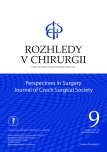Regenerative abilities of a nanofiber wound dressing based on polylactide
Authors:
K. Menclová 1; P. Svoboda 1; J. Hadač 1; R. Doležel 1; M. Ryska 1; V. Mandys 2; Radek Pohnán 1
Authors‘ workplace:
Chirurgická klinika 2. lékařské fakulty Univerzity Karlovy a Ústřední vojenská nemocnice – Vojenská fakultní, nemocnice Praha
1; Ústav patologie 3. lékařské fakulty Univerzity Karlovy a Fakultní nemocnice Královské Vinohrady, Praha
2
Published in:
Rozhl. Chir., 2021, roč. 100, č. 9, s. 435-439.
Category:
Original articles
doi:
https://doi.org/10.33699/PIS.2021.100.9.435–439
Overview
Introduction: The development of an ideal dressing for wound healing remains an unresolved issue. Thanks to the development of electrospinning technology, polymers in the form of nanofibers have come to the forefront of research interest. A modern and very promising dressing material is a “nonwoven” based on nanofibers of the synthetic polymer polylactide (PLA). The aim of this work was to assess the regenerative abilities of PLA in a standardized wound in a porcine model and compare our results to the literature data.
Methods: We applied PLA-based nanofiber dressings to the standardized wounds created in the porcine model. On the third, tenth, seventeenth and twenty-fourth days after the formation of the defect, we changed the wound dressing while taking a tissue sample for histopathological examination. We continuously monitored serum levels of acute phase proteins.
Results: PLA stimulated an inflammatory response. From the third day, the thickness of the fibrin layer with granulocytes increased. It reached its maximum values on the tenth day (mean 340 μm); at the same time the level of serum amyloid A, as a marker of inflammation, culminated. The individual phases of healing intertwined. The highest thickness values of the granulation tissue with cellular connective tissue (diameter 8463 μm) were reached on the seventeenth day. On the twenty-fourth day, the defects were healed macroscopically with a mean reepithelialization layer of 9913 μm.
Conclusion: PLA-based nanofiber dressing potentiates the inflammatory, proliferative and reepithelialization phases of healing. Its structure perfectly mimics the extracellular matrix and serves as a 3D network for the growth and interaction of cellular elements. In addition to biocompatibility, PLA has a unique ability of two-phase biodegradation. It is a promising material for industrial production of dressing materials. Most of the available studies were performed in vitro. In vivo comparative studies approximating the use of PLA to daily practice are still missing.
Keywords:
nanofibres – polylactide – Wound healing
Sources
1. Eang C, Opaprakasit P. Electrospun nanofibres with superhydrophobicity derived from degradable polylactide for oil/water separation applications. Journal of Polymers and the Environment 2020;28:1484–1491. doi: 10.1007/ s10924-020-01704-z.
2. No HK, Park NY, Lee SH, et al. Antibacterial activity of chitosans and chitosan 4 oligomers with different molecular weights. Int J Food Microbiol. 2002;74:65–72. doi:10.1016/S0168-1605(01)007171-6.
3. Brans TA, Dutrieux RP, Hoekstra MJ, et al. Histopathological evaluation of scalds and 8 contact burns in the pig model. Burns 1994;20(1):48–51. doi:10.1016/0305-4179(94)900906,
4. Ishii D, Ying TH, Yamaoka T, et al. Characterization and biocompatibility of biopolyester nanofibres. Materials 2009;2:1520−1546. doi: 10.3390/ ma2041520,
5. Miguel SP, Figueira DR, Simões D, et al. Electrospun polymeric nanofibres as wound dressings: A review. Colloids and Surfaces B: Biointerfaces 2018;169:60–71. doi: 10.1016/j.colsurfb.2018.05.011.
6. Tharanathan RN, Kittur FS. Chitin – the undisputed biomolecule of great potential. Crit Rev 16 Food Sci Nutr. 2003;43:61–87. doi: 10.1080/1040869039082645.
7. Bacakova L, Filova E, Parizek M, et al. Modulation of cell adhesion, proliferation and differentiation on materials designed for body implants. Biotechnol 3 Adv. 2011;29(6):739–767. doi: 10.1016/j. biotechadv.2011.06.004.
8. Dersch R, Greiner A, Steinhart M, et al. Nanofasern und Nanoröhrchen: Bausteine aus Polymeren. Chemie in Unserer Zeit. 2005;39:26–35. doi:10.1002/ ciuz.200400321.
9. Park JU, Jeong SH, Song EH, et al. Acceleration of the healing process of full-thickness wounds using hydrophilic chitosan-silica hybrid sponge in a porcine model. Journal of Biomaterials Applications 2018;32(8):1–13. doi: 10.1177/0885328217751246.
10. Braekt de MM, Alphen FA, Kuijpers-Jagtman AM, et al. Wound healing and wound contraction after palatal surgery and implantation of poly-(L-lactic) acid membranes in beagle dogs. J. Oral Maxillofac Surg. 1992;50:359–364. doi: 10.1016/0278-2391(92)90398-J.
11. Sullivan TP, Eaglstein WH, Davis SC, et al. The pig as a model for human wound healing. Wound Repair Regen. 2001;9:66–73. doi: 10.1046/j.1524- 475x.2001.00066.x.
12. Henton D, Gruber P, Lunt J, et al. Polylactic acid technology. In: Natural fibers, biopolymers, and biocomposites. Boca Raton, Tylor & Francis 2005;04–08. doi: 10.1201/9780203508206.ch16.
13. Magiera A, Markowski J, Pilch J, et al. Degradation behavior of electrospun PLA and PLA/CNT nanofibres in aqueous environment. Journal of Nanomaterials 2018;15 pages. doi: 10.1155/2018/8796583.
Labels
Surgery Orthopaedics Trauma surgeryArticle was published in
Perspectives in Surgery

2021 Issue 9
Most read in this issue
- Laparoscopic versus open hernia repair in patients with incarcerated inguinal hernia
- Prehabilitation, improving postoperative outcomes
- Omental torsion as a possible cause of acute abdomen
- Atestace
